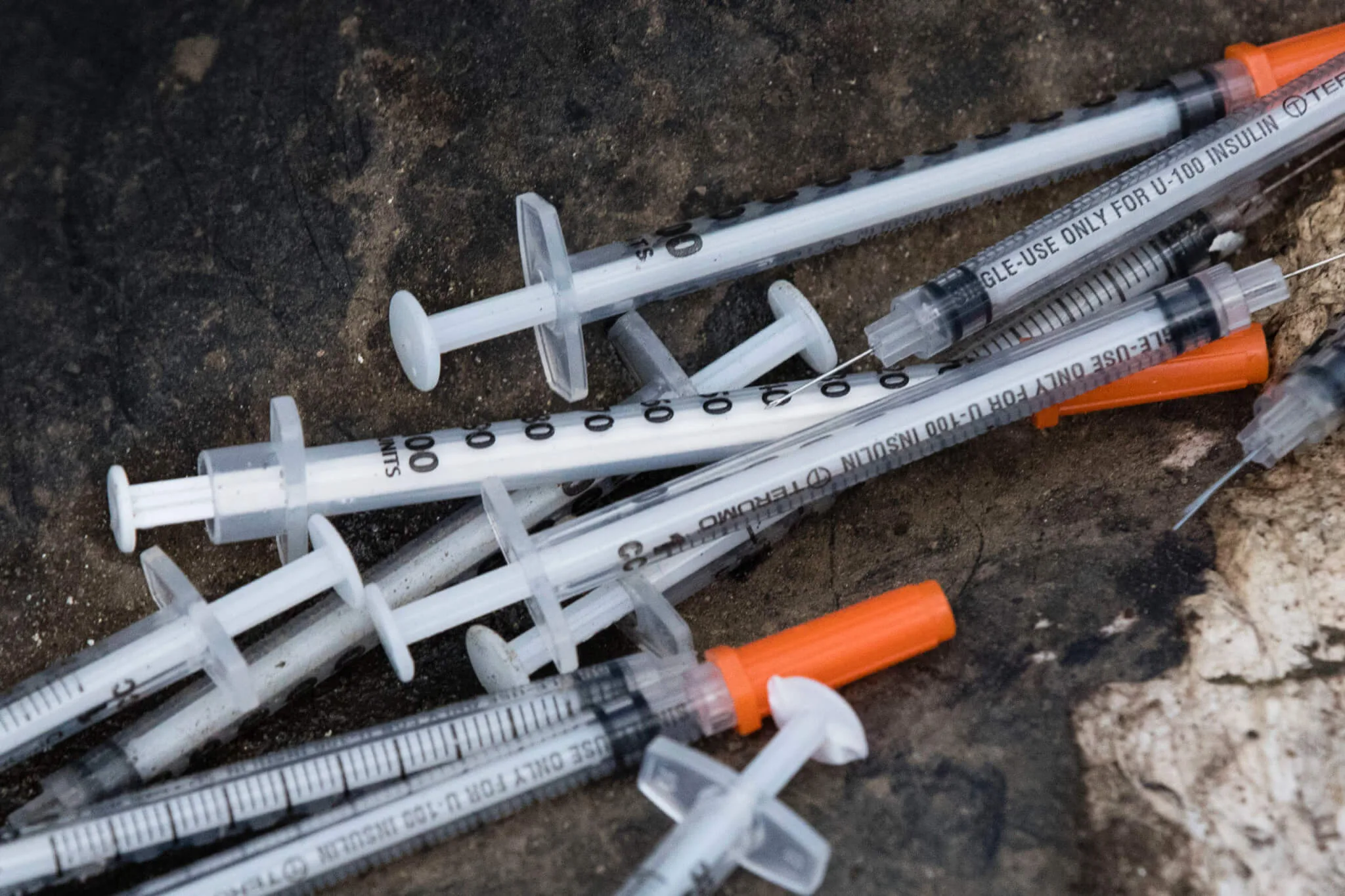
This July 31, 2017, file photo shows discarded syringes in an open-air heroin market that has thrived for decades along train tracks a few miles outside the heart of Philadelphia. (AP Photo/Matt Rourke, File)
State officials anticipate 2020 opioid overdose death totals will exceed those of each of the past three years, including 2017, a year many consider the height of the opioid crisis.
Joanne Troutman’s cousin, Barry, is like a little brother to her.
When they were growing up together in Kulpmont, Northumberland County, Barry started abusing Vicodin and Percocet when he was 12; he stole the prescription pills from medicine cabinets. By 18, he was a full-blown heroin addict.
But he got better.
At the beginning of 2019, Barry had been in recovery for five years, Troutman said. And then the coronavirus pandemic hit.
Barry lost much needed social and family connections, Troutman said. He relapsed.
In the last year, the 36-year old overdosed eight times and is now in county jail for the third time. Troutman said her family is scared that if the heroin doesn’t kill Barry, COVID-19 will.
“I share Barry’s story because there are too many people like him,” said Troutman, president and CEO of the Greater Susquehanna Valley United Way, during a recent public hearing. “Because when we talk about the opioid crisis and statistics and high-level issues that affect so many, it’s so easy to get caught up in the numbers that we forget there are people behind them.”
The opioid crisis was already firmly rooted in rural communities prior to the start of the pandemic, said Attorney General Josh Shapiro. But it has gotten even worse since the pandemic began, adding increased levels of stress and social isolation.

Opioid Overdose Deaths Are on the Rise
State data currently show that 3,954 people in Pennsylvania died from drug overdoses in 2020. That number is likely to increase as the causes of deaths are confirmed and counties report data to the state—a process that can take three to six months.
Jennifer Smith, secretary of the Department of Drug and Alcohol Programs, anticipates 2020 opioid overdose death totals will exceed those of each of the past three years. She said the totals might even climb above the 5,400 deaths in 2017, a year many consider the height of the opioid crisis.
The preliminary data already show there has been a drastic increase in opioid overdose deaths in many rural counties from 2019 to 2020, Smith said.
Judy Rosser, president and director of the Blair County Drug and Alcohol Program, said the Blair County coroner told her office to expect a 78% increase in death totals for the county from 2019 to 2020.
Thirty-five rural counties saw an increase in opioid overdose-related emergency department visits over the last year, Smith said. That’s 72.9% of the state’s 48 rural counties.
“We were beginning to see progress in combating the overdose epidemic in rural communities,” Smith said. “The COVID-19 pandemic has complicated our efforts. And now there is even more work to be done.”

The Opioid Crisis and the Coronavirus Pandemic
“Where you live makes a difference,” Troutman said. “Your genetic makeup makes a difference. Some people have a head start and others are already behind before they’re even out of the gate.”
Issues common in rural areas—limited availability of healthcare services, broadband access problems, and differences in socioeconomic factors and health behaviors—were made worse by the pandemic and greatly affected opioid use, Smith said.
Outpatient treatment providers and county offices were shut down, Troutman said. Inpatient treatment providers weren’t accepting new patients at first and then only with a negative COVID test result.
Troutman said this meant that the normally difficult task of getting someone into treatment became almost impossible.
Vaccine access is also an issue, Smith said. People with substance abuse disorders don’t qualify in Phase 1A of the state’s vaccine rollout, so it could be months until they are vaccinated. Staff and patients in treatment facilities need to be vaccinated to ensure the sustainability of treatment and recovery support.
Increased Isolation Has Led to Increased Opioid Use
Anxiety. Boredom. Loneliness. These emotions coupled with pandemic hardships like job loss, food insecurity, and housing instability have created the perfect conditions for an increase in drug use, Smith said.
Isolation is a risk factor for relapse, Rosser said. Recovery relies on personal connections, 12-step recovery supports, and faith communities—all of which are still being impacted by the pandemic.
“I myself have 33 years of recovery through a faith pathway and I can tell you the isolation produced by the shutdown was real and I am still impacted today as my church has only been able to be open for a short period during the shutdown,” Rosser said.
Recovery groups like Alcoholics Anonymous and Narcotics Anonymous had to meet virtually and participation dropped. Now that socially-distanced, in-person meetings are being held, Troutman said, many are afraid to attend because of the coronavirus.
What Has Been Done About the Opioid Crisis During the Pandemic
Last session, the governor signed legislation enhancing prescription drug monitoring in Pennsylvania and federal requirements for opioid treatment programs were relaxed so services could continue during the pandemic, Smith said.
The use of telehealth to provide counseling and other clinical services has allowed many to remain in treatment while taking the necessary precautions to avoid the coronavirus.
On a local level, Troutman said her organization hired a safe care manager who works with pregnant women and new moms struggling with an addiction. Since October, she has received 41 referrals.
The Greater Susquehanna Valley United Way will also soon launch a recovery housing program and implement PA’s Law Enforcement Treatment Initiative, Troutman said.
“So many people are hurting right now, whether it’s grief, loneliness or physical pain,” she said. “The road ahead will be long. We need stability and support. The impact of COVID and the shutdown will be felt for years.”
What Still Needs to Be Done to Address the Opioid Crisis
The fallout from the pandemic could be felt for years, Shapiro said. And the extent of potential negative effects is endless.
There is much to be done. Investing in treatment, enhancing access to medication-assisted treatments, reducing insurance barriers to treatment, and increasing access to services such as syringe exchange programs are crucial to fighting the opioid epidemic, Shapiro said.
Smith said improved reporting standards accepted and followed by all is another step in the right direction. More real-time data is needed to address issues in a more proactive way, she said.
“The opioid epidemic cannot slip off our radar,” Shapiro said. “We’re still losing 13 Pennsylvanians per day to addiction and overdose. That’s 13 too many.”
Politics

Opinion: Is Reproductive Healthcare just a women’s issue?
In this op-ed, Pennsylvania resident Lynn Strauss discusses the Republican Party’s conflicting stance on reproductive healthcare policy and the...

2 top US gun parts makers agree to temporarily halt sales in Pennsylvania
Philadelphia filed suit against Polymer80 and JSD Supply last year, accusing the manufacturers of perpetuating gun violence by manufacturing ghost...

It’s official: Your boss has to give you time off to recover from childbirth or get an abortion
Originally published by The 19th In what could be a groundbreaking shift in American workplaces, most employees across the country will now have...
Local News

Conjoined twins from Berks County die at age 62
Conjoined twins Lori and George Schappell, who pursued separate careers, interests and relationships during lives that defied medical expectations,...

Railroad agrees to $600 million settlement for fiery Ohio derailment, residents fear it’s not enough
Norfolk Southern has agreed to pay $600 million in a class-action lawsuit settlement for a fiery train derailment in February 2023 in eastern Ohio,...






